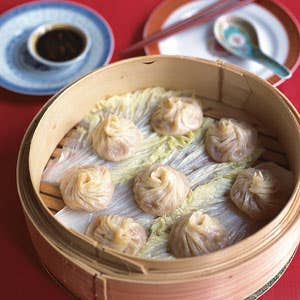
Of all the luscious dumplings China has given the world—the shrimp and water chestnut har gao and the dense, porky siu mai among them—none is quite so ingenious as the xiao long bao, literally, "little dumpling from basket", most often known in the United States as the Shanghai soup dumpling or Shanghai steamed bun. Each small dumpling—typically sized to fit in a Chinese soup spoon—contains, within its delicate wrapper, a tender pork meatball and a mouthful of hot, velvety stock ready to gush luxuriously forth. Like a ship in a bottle, the xiao long bao is a marvelous trick.
Everyone agrees that these dumplings first appeared in Nanxiang, just northwest of Shanghai, at least a century ago. One account cites a snack bar owner, Chen He, as their creator; a more likely tale credits one Wang Mingxian, who is said to have invented them at his Nanxiang pastry shop in 1871. His customers, so the story goes, loved the rich soup surprise and unusually thin wrappers; soon Wang began selling his dumplings at the bustling bazaar around Shanghai's City God Temple. We do know for certain that in 1900 Wang's disciple Wu Xiangsheng established the bazaar's now famous Nanxiang Steamed Bread Shop (Nanxiang Mantou Dian), which sells a staggering 3,000 basketfuls daily.
Xiao long bao is loved all over the world, particularly in Hong Kong (where it's called goon tong gow, "soup-inject dumpling", and may be filled with shark's fin), Taiwan, Toronto, and New York (where you can find a foie gras version).
So, how does soup get into the dumpling? The secret is to tuck tiny cubes of aspic—made from fatty, gelatin-rich pork skin—into the wrapper before closing it, which liquefy when they're steamed. The genius of xiao long bao extends to its shape: the sturdy pleated topknot allows chopsticks to lift the fragile soup-plump dumpling safely and set it on a spoon, for devouring.
Keep Reading
Continue to Next Story










